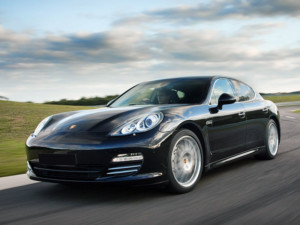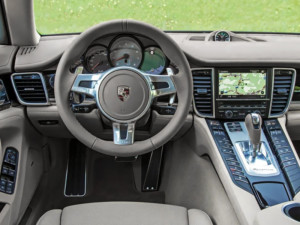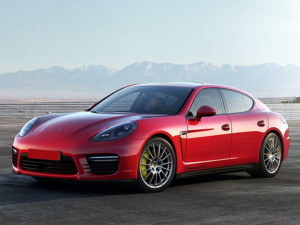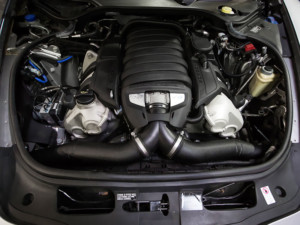The Porsche Panamera Buyers Guide
 Thinking of buying a used Porsche Panamera? Our Porsche Panamera buying guide highlights potetial issues and can help you successfully purchase a used Porsche Panamera.
Thinking of buying a used Porsche Panamera? Our Porsche Panamera buying guide highlights potetial issues and can help you successfully purchase a used Porsche Panamera.
If you’re just about to take the plunge and buy a used Porsche Panamera, this guide will highlight some of the technical issues to be aware of before you commit to buy. The early Panamera cars are now extremely affordable and can be fun to own.
Finding the right car is never simple, but with some luck and armed with the right information, you can pick up a bargain. 10-year-old cars with reasonable mileage are available for 25% of their original cost.
How Do You Tell a Good Porsche Panamera From a Bad One?
Our guide to buying a used Porsche Panamera will help you find the bargain and avoid the bad investment. There’s no fluff or niceties here – there are plenty of resources online that bash on about horse power, cosmetic variants, historical significance and the niceties of the Porsche Panamera.
All well and good, but how do you tell a good Porsche Panamera from a bad one? What are the potential pitfalls? What known problems exist and how do you avoid them? We have the answers you need. We concentrate on the technical things that might cost you money later if you weren’t aware of them prior to buying the car. There are risks if you’re not cautious, but with some insights and careful shopping, there are bargains to be had.


What do we know about the Porsche Panamera so far?
 The Porsche Panamera hit the showrooms in the USA in 2010, and the early used cars are now very affordable. The Panamera is fun and exhilarating to drive yet, can be used as a practical 4 door saloon every day. It’s in the large, fast saloon sector that includes the Mercedes S Class, Audi A8 and BMW’s 7 Series to name but a few competitors. Porsche was a late entrant to this space but sold more than 160,000 Porsche Panamera models during the 970 chassis production run through to 2016.
The Porsche Panamera hit the showrooms in the USA in 2010, and the early used cars are now very affordable. The Panamera is fun and exhilarating to drive yet, can be used as a practical 4 door saloon every day. It’s in the large, fast saloon sector that includes the Mercedes S Class, Audi A8 and BMW’s 7 Series to name but a few competitors. Porsche was a late entrant to this space but sold more than 160,000 Porsche Panamera models during the 970 chassis production run through to 2016.
The Porsche Panamera received a cool reception from Porsche purists, as was the case with the Cayenne. The Panamera is a major departure from the rear engine coupe style car seen as a “Porsche.” Inside, the Porsche Panamera is a sumptuous blend of leather, cockpit style design and modern technology. Outside, well, one wouldn’t describe it as the prettiest in its class by any stretch of the imagination!
Porsche Goes Luxury 4 Door Cruiser
 The original Porsche Panamera was available in the 4.8L S and V8 twin turbo models with a 4wd, V6 Base, GTS and Turbo S subsequently added. During 2011 Porsche added a diesel and hybrid option to the Panamera. Subsequently, the diesel version of course has been discontinued as it really wasn’t as good for the environment as the faked data suggested! The hybrid model had very low sales with just about 4200 units sold during production.
The original Porsche Panamera was available in the 4.8L S and V8 twin turbo models with a 4wd, V6 Base, GTS and Turbo S subsequently added. During 2011 Porsche added a diesel and hybrid option to the Panamera. Subsequently, the diesel version of course has been discontinued as it really wasn’t as good for the environment as the faked data suggested! The hybrid model had very low sales with just about 4200 units sold during production.
The Porsche Panamera 970 chassis continued until 2016 with a mid-production facelift in 2013 designed to address some of the original issues. The 2013 facelift also saw the S model V8 replaced by a turbocharged V6 and the introduction of an improved hybrid model.
As an everyday 4 door saloon, the Porsche Panamera can be quite fun. The Turbo S model delivers 550hp and reaches 62mph in 3.8 seconds while heading for a maximum speed of 191mph. Even the V6 version can reach 160mph! Who needs a 911?
Porsche Panamera Sports Car Technology
The Porsche Panamera comes loaded with technology designed to produce a luxurious ride combined with the nimble and responsive nature of a sports car. Adaptive air suspension, Porsche Dynamic Chassis Control (PDCC), active anti-roll bars and the Porsche Active Suspension Management (PASM), all contribute to an outstanding ride for such a heavy car. A speed activated rear spoiler and 7-speed PDK dual clutch transmission round out the performance technology.
As with most version one of anything, these new ride technology systems caused some of the most prevalent common issues on the Panamera as described below. The rear spoiler system being one of the most hated items! There were also a number of significant recalls for the early Porsche Panamera cars as noted below.
Porsche Panamera Maintenance Costs – Spare Parts – Repairs
 The Panamera is not your standard 4 door saloon and requires more expensive maintenance. That definitely led to some early cars being neglected and servicing overlooked by owners who had not appreciated the potential costs. As with any version one, there are known problems that can catch you out if you are not careful. You’re buying a Porsche, so don’t compare running costs to a small domestic hatchback! Yes, parts and some labor costs will be higher than a typical American or Japanese vehicle. However, save for a few notable items discussed below, the Panamera is solid and reliable.
The Panamera is not your standard 4 door saloon and requires more expensive maintenance. That definitely led to some early cars being neglected and servicing overlooked by owners who had not appreciated the potential costs. As with any version one, there are known problems that can catch you out if you are not careful. You’re buying a Porsche, so don’t compare running costs to a small domestic hatchback! Yes, parts and some labor costs will be higher than a typical American or Japanese vehicle. However, save for a few notable items discussed below, the Panamera is solid and reliable.
The Porsche Panamera shares some parts with the Cayenne platform and most are readily available directly from Porsche. There are plenty of third-party vendors online that can offer parts at lower cost than Porsche directly. There is also a good deal of experience and expertise in independent Porsche repair shops to help make the maintenance of your used Panamera cost effective.
You’re going to pay a little more for an oil change and standard maintenance items, however, don’t try to cheap these. Up keep costs are very similar to the large sedans from other manufacturers that the Panamera competes with. It’s really important to have the car inspected and serviced by a professional with genuine Porsche expertise. A good mechanical understanding of these cars can help identify issues early and save you money in the long term. See our guide to Porsche repair shops for your local expert or contact us and we’ll make a recommendation for you.
Porsche Panamera Scheduled Maintenance
It’s important to understand where the Porsche Panamera you’re considering buying falls within it’s recommended maintenance schedule. Maintenance schedules are based on mileage and elapsed time. Compare the known maintenance history of the Panamera with our recommended maintenance schedules. This should enable you to better understand the asking price, the near future maintenance requirements of the car and perhaps help identify a well maintained Porsche Panamera from a neglected one.
Buying a lightly used Porsche Panamera and not realizing major maintenance is due in the near future, is not the smartest thing you can do!
Porsche Panamera – Where to Buy From?
If you’re trading up from a Porsche Panamera, where are you going? Consider who is selling the car. If you’re buying from a used car dealer, do your research to learn where the dealer got the car. If the dealer specializes in Porsche, this is likely a positive sign. However, if the dealer’s normal trade is low cost mini vans, you need to do some serious thinking. The Panamera can quickly become a pain in the wallet if you pick a bad one.
Many of the vehicles were leased originally and you’ll find good examples as CPO cars at your local Porsche dealer. If you decide to venture into the less costly used Porsche Panamera market, what is the best approach and what should you be paying attention to before you commit to buy?
Pre-purchase Inspection

The first step, once you’ve identified a Panamera candidate, is to get a thorough inspection by a local Porsche expert. The pre-purchase inspection is designed to identify mechanical problems that may not be clearly evident at first glance. In our buyer guide below we’ve extensively highlighted those potential issues to be on the look out for. Getting a repair history on the car, if available, is helpful and will instantly identify or eliminate potential problem areas.
The number of previous owners doesn’t necessarily matter, but it’s wise to consider this type of car is likely to be owned for the purposes of business use, long commutes and family weekends. Expect to see higher mileage from fewer owners and hopefully a regular maintenance pattern.
If a seller wont let you inspect the car, walk away.
Porsche Panamera Potential Mechanical Issues
Coolant Leaks
This is a critical area to be sure of before you commit to purchase. The range of coolant leak resolutions go from a small hose issue all the way to an engine removal. This is an area that requires careful examination of the engine for the tell tail signs of a coolant leak – we’d recommend you use a Porsche repair shop to evaluate this before you buy.
 The early V8 Panameras had a series of coolant pipes that were glued into their housings – great idea! Like all glue, over time the seal begins to fail and coolant leaks out. There are two likely spots for this to occur – the front of the engine or the rear of the engine close to the transmission joint.
The early V8 Panameras had a series of coolant pipes that were glued into their housings – great idea! Like all glue, over time the seal begins to fail and coolant leaks out. There are two likely spots for this to occur – the front of the engine or the rear of the engine close to the transmission joint.
The leak at the front of the engine is from the upper front coolant pipe which slips out of its housing when the glue fails. Porsche revised the design of the replacement part to be bolt in, so the problem should not return. This issue is common and typically runs about $500 in parts.
The leak at the rear is much more of an issue. A rubber hose is clamped to an aluminum insert in the housing that distributes coolant between the cylinder heads in the V8. The glue fails on the aluminum insert and coolant leaks out. The replacement part is updated with a screw in insert for the rubber hose to connect to.
The problem is getting this new assembly attached to the engine. Porsche recommends engine and transmission removal, which puts the cost for this minor leak into big money territory. Some repair shops have devised ways to get this job done without removing the engine assembly and can save their customers significant amounts of money.
Porsche Ceramic Composite Brake Option
 If your considering a Panamera with the PCCB option fitted, it’s absolutely essential to have a professional opinion of the mileage remaining on the brakes.
If your considering a Panamera with the PCCB option fitted, it’s absolutely essential to have a professional opinion of the mileage remaining on the brakes.
The PCCB or ceramic brake setup was a factory fitted option for the Panamera. Porsche Ceramic Composite Brakes (PCCB) use cross-drilled, carbon fiber reinforced ceramic discs with special composite pads. They produce amazing stopping power and are 50% lighter than a standard brake a setup. They also have a considerably longer life than their standard counterparts. However, the expected life of the PCC brakes does not always play out in reality.
If you are buying a Porsche Panamera that has the PCCB option, it’s worth being certain how much life remains on the brakes. Parts for the front brakes alone could run you more than $15,000. Sounds like a good reason for selling a car!
Porsche Panamera Rear Spoiler Malfunction
 It’s very cool to have a spoiler that raises and lowers based on speed, however, failure of this system can be expensive. We recommend popping $3000 in a savings account to prepare for the eventual failure of your Panamera spoiler – it’s going to happen. So, it’s very important to understand the current state of functionality with the spoiler in the used Panamera you plan to buy.
It’s very cool to have a spoiler that raises and lowers based on speed, however, failure of this system can be expensive. We recommend popping $3000 in a savings account to prepare for the eventual failure of your Panamera spoiler – it’s going to happen. So, it’s very important to understand the current state of functionality with the spoiler in the used Panamera you plan to buy.
Commonly, the actuators for the rear spoiler will fail causing the lopsided or failure to raise faults. Messages appear on the dash indicating “failure spoiler control.” There are a number of possible causes for this issue, but the most common is a failure of the rams that raise and lower the spoiler mechanism.
The bad news is the spoiler is not serviceable. Replacement of the whole system is required and Porsche typically wants $3K or more to make this happen. Ouch!
Porsche Panamera Engine Fault Codes
 Before buying a Panamera, it is essential to know when the last time the system fault codes were cleared and check the status of the emission monitors. It’s not difficult for a seller to clear the faults just before you arrive for a test drive.
Before buying a Panamera, it is essential to know when the last time the system fault codes were cleared and check the status of the emission monitors. It’s not difficult for a seller to clear the faults just before you arrive for a test drive.
Clearing the engine faults also resets the emissions system to a state of “not ready.” Emission readiness tests often occur over multiple drive cycles. So, after a reset, emission faults may not return for a significant number of miles or drive cycles.
For example, the V6 Panamera engine will develop a vacuum leak and set a check engine light. There can be many causes, but one of the most common is the failure in the PCV system. A failed diaphragm in the oil separator on the valve cover, allows un-metered air to enter the intake system and cause the engine to run lean. Once cleared, this fault may not return to be indicated on the dashboard as a CEL for a number of drive cycles.
The separator is built into the valve cover and cannot be replaced individually, so the repair requires the replacement of the whole valve cover assembly. Not an over expensive job as the engine and valve cover come from VW, but something to be aware of before you buy.
Camshaft Adjuster Failure – Porsche Panamera Recall
 Generally, this affects the V8 engines produced between 2010 and 2012 model years. The problem lies in the aluminum bolts that secure the timing chain sprockets to the camshaft adjusters.
Generally, this affects the V8 engines produced between 2010 and 2012 model years. The problem lies in the aluminum bolts that secure the timing chain sprockets to the camshaft adjusters.
These engines have adjustable cam timing systems and timing chains that drive the adjuster to vary the position and rotation of the cam based on engine performance demands. Unfortunately, the bolts holding the adjuster to the camshaft break and cause a loss of timing on the camshaft and in some circumstances, significantly worse outcomes such as a catastrophic engine failure.
Porsche was required to recall 2010 through 2012 vehicles to correct this problem. If you are looking at a model in those production years, you should definitely check for evidence the recall work was completed. More information on the recall at http://www.camshaftadjusterrecall.com/
Porsche Active Suspension Management
 The Panamera features an air ride suspension system with an active management system layered on top. There are many components in the system and a small failure in any one component can cause the whole system to go into a state of compromise.
The Panamera features an air ride suspension system with an active management system layered on top. There are many components in the system and a small failure in any one component can cause the whole system to go into a state of compromise.
The concept of air ride suspension on a larger vehicle is a relative novelty in Porsche circles. Consequently, problems with this system are often overlooked or misdiagnosed. However, the physical suspension system is very similar to the Mercedes Benz version, where good experience exists over a longer period with more vehicles. An independent repair shop with a mix of Porsche and Mercedes Benz expertise can be very useful if you have issues with the Panamera suspension.
When buying a used Panamera, it’s essential to get a good understanding of how the suspension is performing. Have the ride height measured and compare corners. Raise and lower the car to check the functionality. Don’t accept a car with any significant difference in the ride heights across an axle. Repairs to the system vary in cost dramatically from minor to very significant.
We have significantly more detail on this system in our Panamera common problems section.
Engine Overheating
 When shopping for a used Panamera, some patience is required after a test drive.
When shopping for a used Panamera, some patience is required after a test drive.
The Panamera is known to have problems with the auxiliary coolant pump and can experience an engine overheating problem at low revs. So, after you’ve enjoyed the test drive and the engine is warm let the car sit and idle for 15 mins before you turn off.
The electric auxiliary coolant pump is designed to assist the main water pump when engine revs are low, such as at idle in traffic. The failure of the pump causes the coolant temp to rise rapidly and set engine overheating faults. The engine may also go into a self protection mode and shutdown completely. Typically this will occur when the car is sitting still for longer periods, such as bad traffic and will not be seen while driving.
Where’s The Oil Dipstick on the Porsche Panamera?
 If you are used to checking your engine oil level and using a dipstick, there isn’t one! Checking the oil in your Panamera requires a new procedure that you need to be aware of before you buy a used version. All of the oil measurement is done through the dashboard screen.
If you are used to checking your engine oil level and using a dipstick, there isn’t one! Checking the oil in your Panamera requires a new procedure that you need to be aware of before you buy a used version. All of the oil measurement is done through the dashboard screen.
The oil level is measured electronically for accuracy. This is awesome, assuming the electronic measurement is accurate or is at the very least telling you the truth. There is no manual backup of the tried and trusted dipstick – so did you overfill or under fill? Or do you have a faulty sensor?
Oil Top Off
The Panamera engine will naturally consume oil while you drive. Different driving styles and conditions will cause oil consumption to change. With the extended mileage between oil changes that manufacturers have opted for, it’s very likely the car will call for additional oil between scheduled service intervals.
If the Panamera you buy calls for additional oil, here’s what to do:
- Ideally, the engine should be at operating temperature
- The difference between the minimum and maximum reading is approx. 1 quart
- Do not add more than 1 quart at a time
- Remeasure the oil level after each quart added
- After adding a quart, drive the car for 5 to 10 mins before rechecking the level
- Oil reading is not instant and requires a drive cycle before reporting a change
Pretty…Ugly Porsche Panamera
Well, it’s not the most attractive car Porsche has produced, but it is improving. The interior is excellent and has a cockpit feel as you relax behind the wheel. Early versions are now available for reasonable money and as a high end salon car, it can punch its weight for the sector.




